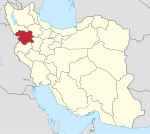District in Kurdistan province, Iran
District in Kurdistan, Iran
The Central District of Sanandaj County (Persian : بخش مرکزی شهرستان سنندج ) is in Kurdistan province, Iran . Its capital is the city of Sanandaj .[ 3]
History
In 2011, Hoseynabad-e Jonubi Rural District was separated from the district, and Hoseynabad-e Shomali Rural District was separated from Saral District of Divandarreh County in the formation of Hoseynabad District .[ 4] Zhavarud-e Sharqi Rural District was separated from the Central District to form Sirvan District .[ 5]
Demographics
Population
At the time of the 2006 National Census, the district's population was 386,738 in 99,692 households.[ 6] [ 7] [ 2]
Administrative divisions
Central District (Sanandaj County) Population
Administrative Divisions
2006[ 6]
2011[ 7]
2016[ 2]
Abidar RD 14,274
6,693
5,921
Arandan RD 4,012
5,125
5,458
Hoseynabad-e Jonubi RD [ a] 7,467
6,787
Howmeh RD 31,304
20,066
28,597
Naran RD 5,754
4,943
3,686
Sarab Qamish RD 4,719
4,785
4,849
Zhavarud-e Sharqi RD [ b] 7,762
6,224
Sanandaj (city)311,446
373,987
412,767
Total 386,738 428,610 461,278
RD = Rural District
See also
Iran portal
Notes
References
^ OpenStreetMap contributors (28 December 2024). "Central District (Sanandaj County)" (Map). OpenStreetMap . Retrieved 28 December 2024 . ^ a b c Census of the Islamic Republic of Iran, 1395 (2016): Kurdistan Province . amar.org.ir (Report) (in Persian). The Statistical Center of Iran. Archived from the original (Excel) on 8 May 2022. Retrieved 19 December 2022 .^ Habibi, Hassan (2 November 2017) [Approved 21 June 1369]. Approval of the organization and chain of citizenship of the elements and units of the national divisions of Kurdistan province, centered in the city of Sanandaj . rc.majlis.ir (Report) (in Persian). Ministry of the Interior, Defense Political Commission of the Government Board. Proposal 3233.1.5.53; Letter 907-93808; Notification 83352/T130K. Archived from the original on 23 October 2018. Retrieved 22 January 2024 – via Islamic Parliament Research Center of the Islamic Republic of Iran. ^ a b "Three new cities were added to the map of the country's divisions; with some changes in the geography of four provinces" . dolat.ir (in Persian). Ministry of the Interior, Political and Defense Commission. 6 October 2011. Archived from the original on 12 April 2018. Retrieved 15 November 2023 – via Secretariat of the Government Information Council.^ a b Rahimi, Mohammad Reza (13 November 2017). With the approval of the Council of Ministers, some changes in the map of the national divisions of Kurdistan province . dolat.ir (Report) (in Persian). Ministry of the Interior, Political and Defense Commission. Archived from the original on 4 November 2018. Retrieved 15 November 2023 – via Secretariat of the Government Information Council. ^ a b Census of the Islamic Republic of Iran, 1385 (2006): Kurdistan Province . amar.org.ir (Report) (in Persian). The Statistical Center of Iran. Archived from the original (Excel) on 20 September 2011. Retrieved 25 September 2022 .^ a b Census of the Islamic Republic of Iran, 1390 (2011): Kurdistan Province . irandataportal.syr.edu (Report) (in Persian). The Statistical Center of Iran. Archived from the original (Excel) on 19 January 2023. Retrieved 19 December 2022 – via Iran Data Portal, Syracuse University.


